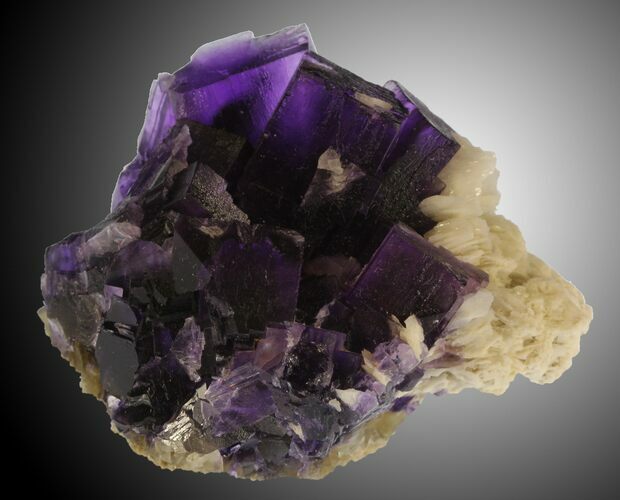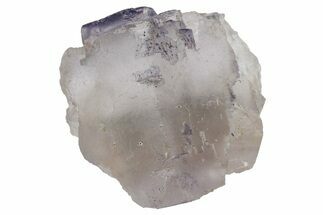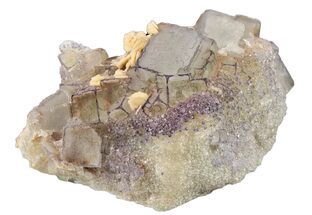This Specimen has been sold.
Gorgeous 2.68" Cubic Fluorite on Bladed Barite - Cave-in-Rock, Illinois
This is a gorgeous purple and yellow cubic fluorite on bladed barite from the Cave-In-Rock district of Harden County, Illinois. Although there are some minor natural fractures, the crystal is in overall great shape, and has lots of unique geometry to explore.
Barium Sulfate (BaSO4) is a common mineral often found associated in matrix with other minerals such as fluorite, quartz, pyrite, and calcite. Usually barite forms as white crystals, and contrasts the other minerals that it forms with nicely.
Archaeological discoveries near the Cave-In-Rock mining district of beads and other ornaments made of fluorite have placed the use of the stone to about 900 years ago when the land was inhabited by the Native Mississippian Americans. Early European settlers mining for galena in the 1830's discarded the fluorite as the lead they sought was more valuable at the time. In the 1880's it was discovered that fluorite was very useful in a new steel-furnace technology, and demand increased considerably, and several commercial fluorite mining companies appeared in Illinois/Kentucky region.
About Fluorite
Fluorite is a halide mineral comprised of calcium and fluorine, CaF2. The word fluorite is from the Latin fluo-, which means "to flow". In 1852 fluorite gave its name to the phenomenon known as fluorescence, or the property of fluorite to glow a different color depending upon the bandwidth of the ultraviolet light it is exposed to. Fluorite occurs commonly in cubic, octahedral, and dodecahedral crystals in many different colors. These colors range from colorless and completely transparent to yellow, green, blue, purple, pink, or black. Purples and greens tend to be the most common colors seen, and colorless, pink, and black are the rarest.
Fluorite is a halide mineral comprised of calcium and fluorine, CaF2. The word fluorite is from the Latin fluo-, which means "to flow". In 1852 fluorite gave its name to the phenomenon known as fluorescence, or the property of fluorite to glow a different color depending upon the bandwidth of the ultraviolet light it is exposed to. Fluorite occurs commonly in cubic, octahedral, and dodecahedral crystals in many different colors. These colors range from colorless and completely transparent to yellow, green, blue, purple, pink, or black. Purples and greens tend to be the most common colors seen, and colorless, pink, and black are the rarest.
Barium Sulfate (BaSO4) is a common mineral often found associated in matrix with other minerals such as fluorite, quartz, pyrite, and calcite. Usually barite forms as white crystals, and contrasts the other minerals that it forms with nicely.
Archaeological discoveries near the Cave-In-Rock mining district of beads and other ornaments made of fluorite have placed the use of the stone to about 900 years ago when the land was inhabited by the Native Mississippian Americans. Early European settlers mining for galena in the 1830's discarded the fluorite as the lead they sought was more valuable at the time. In the 1880's it was discovered that fluorite was very useful in a new steel-furnace technology, and demand increased considerably, and several commercial fluorite mining companies appeared in Illinois/Kentucky region.
SPECIES
Fluorite, Barite
LOCATION
Cave-In-Rock, Harden County, Illinois
SIZE
2.68x2.12x1.71"
CATEGORY
SUB CATEGORY
ITEM
#32194
 Reviews
Reviews
















